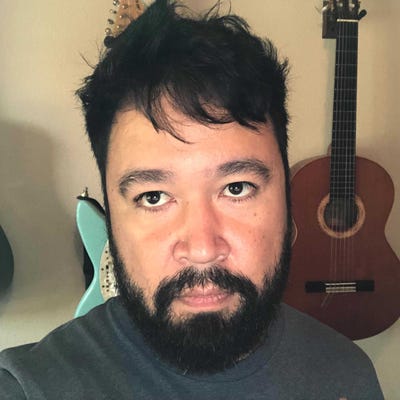In the latest Road to the IGF interview with 2010 Independent Games Festival finalists, Gamasutra speaks with Krystian Majewski, the indie behind the triple-nominated adventure game Trauma.

[In the latest Road to the IGF interview with 2010 Independent Games Festival finalists, Gamasutra speaks with Krystian Majewski, the indie behind the triple-nominated adventure game Trauma] Krystian Majewski's goal with his photographic adventure game Trauma was to be nominated for the Independent Games Festival. He reached his goal three times over, as Trauma has been nominated for Excellence in Visual Art, Excellence in Audio, and the coveted Seamus McNally Grand Prize in IGF 2010. In the creation of intriguingly-navigated adventure title Trauma, Majewski analyzed the adventure game genre closely, paying attention to its trends over the years, finding out where they fall flat, and experimenting with new ideas. In this interview, Majewski offers a bit of his personal background, how Trauma came to be, and why he thinks "big budget titles maneuvered themselves into a dead end" on a creative level. What kind of background do you have making games? I've been making computer games since I was 10 or so. The oldest game I still have is from 1993. I was 12 back then. It is a pretty unique 4X space colonization game made in Visual Basic. After high school, I briefly worked for Neon Studios in Frankfurt but went on studying design very soon. During my studies, I realized that triple-A game production really isn't very promising to me right now. Instead I looked into other possibilities like Flash games and independent games. What development tools did you use? For Trauma, I used Flash. The game is built upon the Papervision 3D engine and includes the ByteArray mouse gesture recognition library. As for the content, I used an old Sony DSC-F717 camera I got from Ebay. For some reason, it makes the most excellent photos. It might be because of it's extraordinary lens. Plus, the camera itself looks quite futuristic too. The photos where then manipulated in lots of different ways using all sorts of tools and techniques. Each effect was a unique challenge and it would take too long to list them all. Let's just say I "photoshopped" them. How long has your team been working on Trauma? Trauma was created as a project for my final thesis. I wrote the first abstract in winter 2007. I began really working on in in spring 2008. I got Martin Straka - my musician - on board pretty early. By the late summer 2008 I had the first level going, presented is for my final exam and was even considering submitting it for IGF 2009. However, due to some personal problems, the development got stuck and I decided to wait. The following year was difficult but we've managed to do some work for it on and off. Everything came together by the late summer 2009. This is also when I also did the voice recording. So all in all, I'd say one-and-a-half years so far. It's still not quite finished. How did you come up with the concept for the game? It's quite unique. It was a longer process. I did a lot of experiments. I did a thorough analysis of the history of adventure games. I took a close look at a lot of current spin-offs like the escape-the-room genre or hidden object games. I tried to identify advantages as well as problems and distill a new kind of an adventure game. What about the presentation? What inspired the slideshow feel? One of the few things I decided early on was using photos. I loved the look of Samorost. It made me notice that for some odd reason games rarely use photographs. I've seen Photosynth and I was a huge inspiration. But I kept my mind open and tried all sorts of ways of using photographs. I went around at night and made a lot of different experiments. I've even built a robotic camera tripod out of LEGO that could shoot spherical panoramas automatically. It worked but I ended up not using it during production. In the end, after comparing the results of my experiments, the Photosyth-like approach was the most promising one. Why did you feel that a gesture-based system would work best? At the time where I was still experimenting, there was a lot of talk about the Wii, DS and the iPhone. I had some opportunities to show the game at exhibitions. So I tried a gesture-based interface and I was quite happy with the results. The deal was sealed when I came up with the lightpainting effect for visualization. It was a perfect fit for the photographic nature of project. You say that you wanted to focus on a "rich experience rather than an elaborate puzzle challenge." What's the reasoning behind that? If you look back at the history of games and especially at the history of adventure games, you might see that they all got less challenging with time. The early text adventures were these insane punishing puzzles where you could die or get stuck at every corner. As games matured, they got less and less punishing. One great example is how the LucasArts adventures eliminated death from adventure games. This doesn't mean that the games got boring. They just focused more on different values. Even back in the 90s, developers of adventure games realized that many players played the games not because of the puzzles but simply because they enjoyed the mood and the environment. Cyan, the studio that made Myst, called them "Tourists". You can see similar ideas in many modern games like Shadow of the Colossus and certainly in indie titles like Knytt. In many ways, Trauma embraces that philosophy. There are puzzles but they are simple and pretty straight-forward. And if you miss something, the game will spell them out for you. The entire game is over very soon. If you stay longer it's because you are interested, not because you got stuck. This doesn't mean that I think every game should be easy to solve. Challenge can be a very powerful way to engage and captivate a player. It's just one of many different ways to create interactive experiences and I wanted to explore an alternative. What are the next steps with the development of Trauma, and what is the ultimate goal of the project? Being nominated for IGF was the main goal for me. Yet, I still can't quite believe that I actually made it. The competition is daunting and everybody has clearly put so much heart into their games. I've been sitting on this for such a long time. At this point my only goal is to get it done and get it out there for people to play. Hearing from others what they think of it is a tremendously exciting experience. In a weird way, It is now when even I myself finally discover what the game is about. Have you played any of the other IGF finalists? Any games you particularly enjoyed? I've played Super Meat Boy, Shatter, Enviro-Bear 2000 and Today I Die. I love all of them. I must admit that I didn't quite understand Meat Boy. But I'm looking forward to meet [Team Meat's] Edmund McMillen, maybe he can explain. What do you think of the current state of the indie scene? I'm very excited about the explosive growth of the scene in the last years. Independent games are now an alternative to big budget titles and certainly show the way in terms of creativity. It seems to me like big budget titles maneuvered themselves into a dead end there, which is one of the reasons why didn't pursue a career in the industry. If I could make one wish, I would wish for more indie developers concentrating on meaning rather than experimenting with gameplay mechanics. So far the scene seems to be saturated with re-makes of established genres with a few new twists or funky graphics. I have nothing against yet another retro 2D platformer but I would also like to see at least as many efforts to create titles that have something to say. I believe this is the reason why Trauma stands out. Finding out ways on how games can relate to topics we deal with in everyday lives is one of the hardest challenges. It is also a challenge with the biggest payoff in terms of evolving the medium. It is a challenge that I believe only indies can properly take upon. [Previous 'Road To The IGF' interview subjects have included Enviro-Bear 2000 developer Justin Smith, Rocketbirds: Revolution's co-creators Sian Yue Tan and Teck Lee Tan, Vessel co-creator John Krajewski, and Super Meat Boy co-creators Edmund McMillen and Tommy Refenes.]
About the Author(s)
You May Also Like









